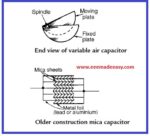In this posts, Indian Electricity Rule MCQ Questions and Answers are given. The Detailed IE rules are given in another Post IE Rules.
How many earth connections are required for the motor frame as per the IE rule 61?
- One
- Two separate and distinct
- Three separate and distinct
- All of these
Ans: Two separate and distinct
IE Rule 61 (2): The frame of every generator, stationary motor, portable motor, and the metallic parts (not intended as conductors) of all transformers and any other apparatus used for regulating or controlling energy and all medium voltage energy consuming apparatus shall be earthed by the owner by two separate and distinct connections with earth.
According to the electricity rule, which type of pole is not used in the overhead line?
- Concrete poles
- Rail electric poles
- Silicon PVC poles
Ans: Silicon PVC poles
Types of poles used in overhead line
1.) Wooden poles
These are made of seasoned wood (sal or chir) and are suitable for lines of the moderate X-sectional area and of relatively shorter spans, say up to 50 meters.
Such supports are cheap, easily available, provide insulating properties, and, therefore, are widely used for distribution purposes in rural areas as an economic proposition.
These cannot be used for voltages higher than 20 kV.
2.) Steel poles
Steel poles are often used as a substitute for wooden poles.
They possess greater mechanical strength, and longer life and permit longer spans to be used.
Such poles are generally used for distribution purposes in the cities.
3.) RCC poles
The reinforced concrete poles have become very popular as line supports in recent years.
They have greater mechanical strength, longer life, and permit longer spans than steel poles.
Moreover, they give a good outlook, require little maintenance, and have good insulating properties.
4.) Steel towers
In practice, wooden, steel, and reinforced concrete poles are used for distribution purposes at low voltages, say up to 11 kV.
However, for long-distance transmission at higher voltage, steel towers are invariably employed.
Steel towers have greater mechanical strength, longer life, can withstand most severe climatic conditions, and permit the use of longer spans.
Which of the following Indian Electrical Rules describes about the periodical and testing of consumer’s installation?
Ans: Rule 46
Read: Which IE rule is applicable to service mains?|Indian Electricity Rule
Read Also: [PDF]IE Rules|Indian Electricity Rules 1956
Which act is used to regulate the Indian power sector today?
- Indian Electricity Act 1910
- Indian Electricity Act 1948
- Indian Electricity Act 2000
- Indian Electricity Act 2003
Ans: Indian Electricity Act 2003
More on Electricity Rules
- [Updated]List of IS Codes Electrical standards|IS 732, IS 3043 etc|Indian electrical standards
- [Class A,B,C]Electrical Contractor Licence in Kerala Class A, Class B, Class C|How to get Electrical Contractor License Kerala|Electrical Supervisor Permit A and B
- [Complete Guide] Class A Electrical Contractor Licence Application, Renewal
- [PDF]IE Rules|Indian Electricity Rules 1956
- Which IE rule is applicable to service mains?|Indian Electricity Rule
- [PDF] Electricity Act 2003|Indian Electricity Act 2003 PDF
- Which act is used to regulate the Indian power sector today?
- Indian Electricity Rules MCQ|IE Rules Questions
Latest Posts EEE Made Easy
Latest Posts in EEE Made Easy
- RRB JE CBT 2 Exam Date 2025 Postponed|RRB JE CBT 2 Exam Date
- [PDF]RRB JE Result 03/2024 Cut off, Selected no of candidates for all regions
- [PDF]Final Answer Key Junior Instructor Mechanic Agricultural Machinery|643/2023 Solved Question paper
- Acoustics MCQs|Industries Extension officer|IEO 2025
- LASER MCQs| Industries Extension officer|IEO 2025
- Practical Types of Capacitors
- [PDF] Syllabus JUNIOR INSTRUCTOR MECHANIC AGRICULTURAL MACHINERY|643/2023 Syllabus Kerala PSC



